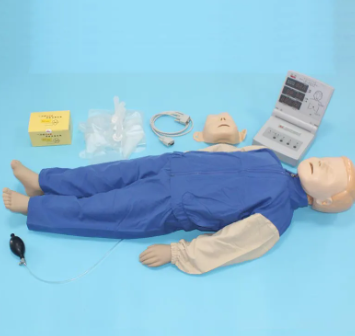Welcome to visitShanghai Chinon medical Model & Equipment Manufacturing Co., LTD
Child CPR models play a vital role in improving first aid skills. Here are a few key points of how the model can help improve first aid skills:

1. Simulate real scenes to enhance practical ability
The child cardiopulmonary resuscitation model can highly simulate the physiological response and pathological state of children in emergency situations, such as cardiac arrest and suffocation. By training in these simulated scenarios, medical staff can experience and respond to various first aid situations, thereby enhancing their practical ability and confidence in responding to emergencies.
2. Provide real-time feedback and adjust operation skills
Many advanced child CPR models are equipped with advanced sensors and monitoring systems that are able to monitor the medical staff's operation in real time, such as depth of compression, frequency, effectiveness of artificial respiration, and provide detailed feedback. This real-time feedback mechanism helps the medical staff to adjust the operation method in time and correct errors, thus improving the accuracy and effectiveness of first aid skills.
3. Diversified training modes to meet different needs
Children's cardiopulmonary resuscitation models usually provide a variety of training modes, such as autonomous training, teacher guidance, etc., to meet the learning needs of different students. In the autonomous training mode, students can practice first aid operation independently to consolidate their knowledge; In the teacher-guided mode, the key points of first aid skills can be quickly mastered through the guidance and feedback of professional teachers.
4. Teamwork training to improve tacit understanding
The child CPR model also supports teamwork training. In the simulated first aid scenario, medical personnel need to work closely with other team members to complete the first aid task. This teamwork training helps to improve the understanding and collaboration between medical personnel, ensuring that an effective rescue team can be quickly formed in real emergency scenarios.
5. Practice repeatedly to improve proficiency
By repeatedly using the child CPR model for training, medical staff can continuously consolidate and improve their proficiency in first aid skills. This process of repeated practice helps to translate theoretical knowledge into practical skills, enabling medical personnel to respond quickly and accurately when faced with real emergency situations.
In summary, the child cardiopulmonary resuscitation model effectively helps medical staff improve their first-aid skills by simulating real scenarios, providing real-time feedback, supporting diversified training modes, teamwork training, and repeated practice. This is of great significance for improving the success rate of children's first aid and ensuring children's life safety.
|
NEXTпјҡHow can skull models help us bridge the anatomical cognitive gap
LASTпјҡWhat are the differences and connections between foot acupuncture model and real practice? |
Return list |